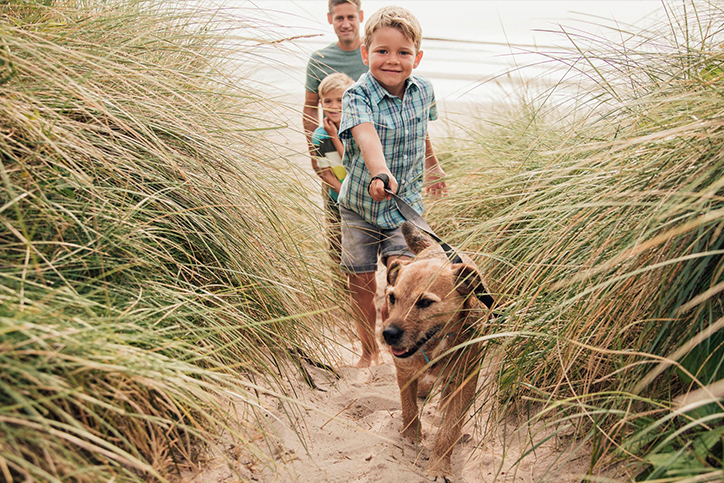When it comes to fitness dogs have the best attitude. 12/10 would agree. They’re always ready for a walk, never tired of fetching a tennis ball and always excited about their next adventure. Research shows that just having a dog can improve human fitness levels. Dog owners are consistently more active than people without K-9’s, on average walking 22 minutes more daily compared to non pet owners.
Five ways your pup can inspire your fitness life

Enjoy moving
Have you ever noticed how much joy and happiness there is at a dog park? The dogs are running, jumping, fetching, playing and generally acting like this is the greatest day of their lives. Dogs don’t have to meditate to be mindful, they are just in the moment no matter what. Dogs also don’t have some of the less productive human concerns, such as wondering if they wore the right outfit to the gym, if the other dogs are lifting more weight than them or if they have any new likes on Instagram.
We humans can enjoy our workouts more by taking a few cues from the puppers. Turning off cell phones and other devices to really connect with the body and breath during a workout can help boost enjoyment. Research shows that you’ll also get better results this way. And if you tune in and realize you don’t really enjoy the workout you’re are doing, try something else. What is your version of the dog park that will make you jump for joy and shake with anticipation when someone says walk?
Learn to Relax and Recover
As excited as dogs get to hit the trail or go to the beach, they are equally jazzed about taking a long nap after they have given it their all. Dogs know how to work/play hard and then really relax and recover. Humans could benefit from this approach as well since its during times of rest and recovery from your last workout that the body repairs itself to get stronger and fitter. Taking enough rest and recovery between workouts is as important as the workouts themselves to maximize results and avoid injury, overtraining and burnout.
Stretch when feeling stiff
Have you ever noticed dogs stretch whenever they get up from a nap or any other position they may have been in for a while? There’s a reason why downward facing dog is one of the fundamental positions in yoga. As humans we tend to avoid stretching all together or do it during a dedicated workout time only. What if we did a few stretches everytime we felt a little stiff? After driving to work, sitting at our desks or getting out of bed? A few stretches throughout the entire day can be much more effective than stretching once a week or not at all. Your dog isn’t self conscious about stretching whenever he feels like it, why should you be?
Advocate For Yourself
Dogs know what they want, whether its food, water, walks, head scratches, etc. They are excellent at getting in touch with their own needs and letting you know what they would like. It’s a bit more complicated for humans and many of us have gotten into the habit of neglecting our basic needs for healthy food, water and exercise in favor of more abstract goals. We work through lunch, ignoring our stomach rumblings. We skip the gym in favor of Netflix or other pursuits. We pound coffee and energy drinks and forget to drink water. Unfortunately this disconnection can lead to low moods, compromised health and stress. Try getting in touch with your inner puppy and feeling what your body is asking for again. Is it time to eat? Are you longing for some fresh air and a walk? Do you need to turn off the computer and go to sleep? Try taking care of yourself as well as you would your sweet pet.
Reward Yourself
Most dogs are very motivated by food and with enough treats and patients can be trained to do almost anything. Once the behavior is learned, the treat is no longer needed and the trick becomes a habit. Humans can also use this feedback loop to integrate new healthy habits into their lives. Maybe you reward yourself with a square of dark chocolate after trying a new fitness class or a new outfit after reaching your monthly goals. Rewards are very helpful for creating new habits so don’t be afraid to use them, especially in the first 30 days when habits are being formed.